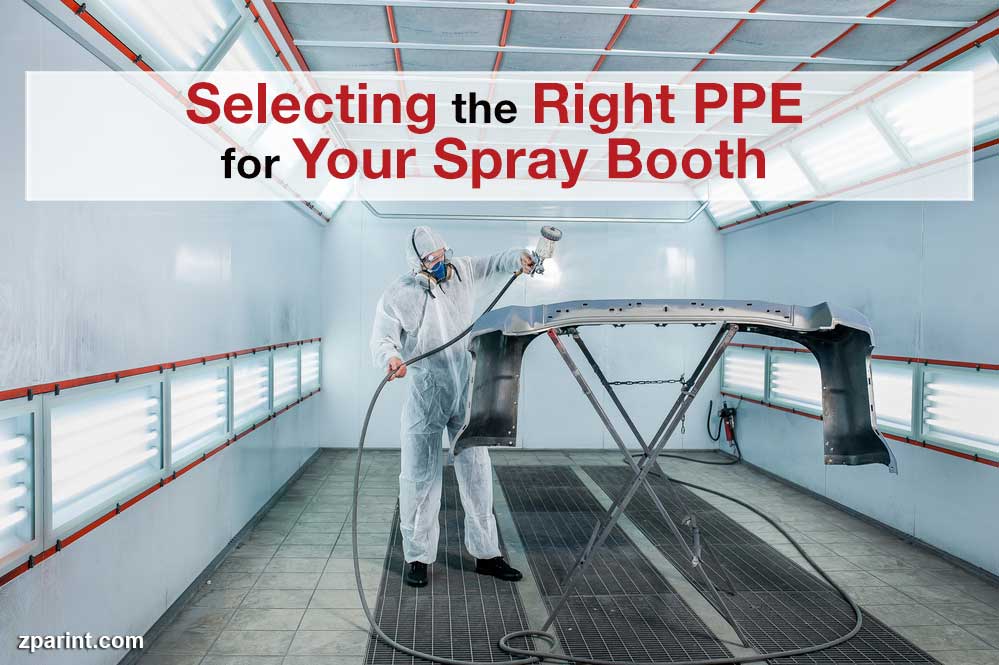Even if your paint booth comes complete with advanced technology, optimal airflow, or other high-end features and functionalities, there’s always a potent risk to the safety and health of your painters. To this end, the utilization of personal protective equipment (PPE) is always mandatory for personnel who work in a spray booth environment. Paint fumes are known to have volatile organic compounds (VOCs) which can be easily ingested by a painter through inhalation or even skin absorption. With this in mind, there are both short-term and long-term health risks of ingesting VOCs. This may include persistent headaches, skin irritation, nausea, vertigo, shortness of breath, and so on. Also, with prolonged or repeated exposure to these substances, these symptoms will get worse and give rise to serious health challenges including throat irritation, severe difficulties in breathing, kidney failure, stroke, chronic obstructive pulmonary disease, and even cancer.
 Many varieties of paint and varnishes are manufactured with isocyanate, a very dangerous substance. When a high level of isocyanate is ingested, the painter will develop breathing issues, hives, asthma, and outbreaks of rashes. In the extreme, when exposure is prolonged, the painter might even lose their life. Should you be on the search for the ideal PPE for your paint booth workers, there will be a number of factors to consider. In the first place, you should always take your time to ascertain just what level of PPE protection will be ideal for the unique needs of your paint shop. You can do this by simply going through the safety data sheet which is included in the packaging of the paint you use. This particular sheet specifies the various hazards contained in the paint. It will also recommend the right PPE that will significantly minimize your spray booth workers’ exposure.
Many varieties of paint and varnishes are manufactured with isocyanate, a very dangerous substance. When a high level of isocyanate is ingested, the painter will develop breathing issues, hives, asthma, and outbreaks of rashes. In the extreme, when exposure is prolonged, the painter might even lose their life. Should you be on the search for the ideal PPE for your paint booth workers, there will be a number of factors to consider. In the first place, you should always take your time to ascertain just what level of PPE protection will be ideal for the unique needs of your paint shop. You can do this by simply going through the safety data sheet which is included in the packaging of the paint you use. This particular sheet specifies the various hazards contained in the paint. It will also recommend the right PPE that will significantly minimize your spray booth workers’ exposure.
Additionally, the local authorities in your given area, including OSHA inspectors, can accurately identify what sorts of PPE are prerequisites for your business’ paint operations. It is vital to state that all PPE aren’t made equal, and no one size fits all requirements. For instance, workers who wear beards or prescription glasses will need different PPE from those who don’t. At the same time, PPE has to fit comfortably and allow the wearer to execute their paint booth tasks adequately, communicate efficiently and retain their mobility at all times. Alternatively, when wearing a respirator is necessary, a fit test must be done to guarantee the face of the wearer is sealed properly. The respirator must snugly fit the face of the wearer and be devoid of openings to prevent inhalation of VOCs. Also, air monitoring of the spray booth will be necessary to enable you to determine its conditions. For example, when the level of particles in the air rises, it could be a clear indicator there is an issue with your unit’s filtering or air makeup system. Well then, here are some of the most essential PPE that are generally used in the paint booth setting.
Painter’s Suits
 To be in a position of preventing dangerous exposure to chemicals like isocyanate in a spray booth, your painters need to wear full-body painter’s suits. There are usually 2 different sorts of these products, which are the disposable and non-disposable varieties. The first solution can be used for no more than one week, and are crafted with thinner materials that may tear easily. This definitely means your painters will have to be very careful particularly when it comes to kneeling on exhaust pit gratings. Non-disposal suits, on their part, are specifically designed to be worn for months on end and are crafted with thicker materials. These products ought to be washed no more than once per week in a washing machine by themselves, using basic detergents and without fabric softeners.
To be in a position of preventing dangerous exposure to chemicals like isocyanate in a spray booth, your painters need to wear full-body painter’s suits. There are usually 2 different sorts of these products, which are the disposable and non-disposable varieties. The first solution can be used for no more than one week, and are crafted with thinner materials that may tear easily. This definitely means your painters will have to be very careful particularly when it comes to kneeling on exhaust pit gratings. Non-disposal suits, on their part, are specifically designed to be worn for months on end and are crafted with thicker materials. These products ought to be washed no more than once per week in a washing machine by themselves, using basic detergents and without fabric softeners.
Gloves
 Generally speaking, nitrile gloves are necessary in a paint booth when a painter sprays or mixes paint. These types of PPE tend to weigh a similar weight to latex gloves, and are designed to permit workers to have an excellent feel of the spray gun. At this juncture, it is important to note that unlike what some people tend to believe, gloves are very necessary when handling waterborne paint. Granted, these kinds of paint contain a lesser content of solvents. However, they still have plenty of substances which are detrimental when they come into contact with a human body.
Generally speaking, nitrile gloves are necessary in a paint booth when a painter sprays or mixes paint. These types of PPE tend to weigh a similar weight to latex gloves, and are designed to permit workers to have an excellent feel of the spray gun. At this juncture, it is important to note that unlike what some people tend to believe, gloves are very necessary when handling waterborne paint. Granted, these kinds of paint contain a lesser content of solvents. However, they still have plenty of substances which are detrimental when they come into contact with a human body.
Breathing Devices
When it comes to tasks such as priming, half masks respirators can be especially suitable. On the other hand, for huge spray booth operations, half masks aren’t as effective due to the higher amounts of overspray that if handled amiss can splatter the painter’s face. Additionally, half masks tend to last for less than one month and must be stored in their packaging and sealed when not in use. Alternatively, there are breathable fresh air systems, which deliver cleaner, outdoor air and feature a 3-step filtration system. They as well have separate lines dedicated to breathable air. Lastly, a carbon monoxide meter is also required in paint booth operations and can be worn by the worker or even be incorporated into the unit’s fresh air system.

